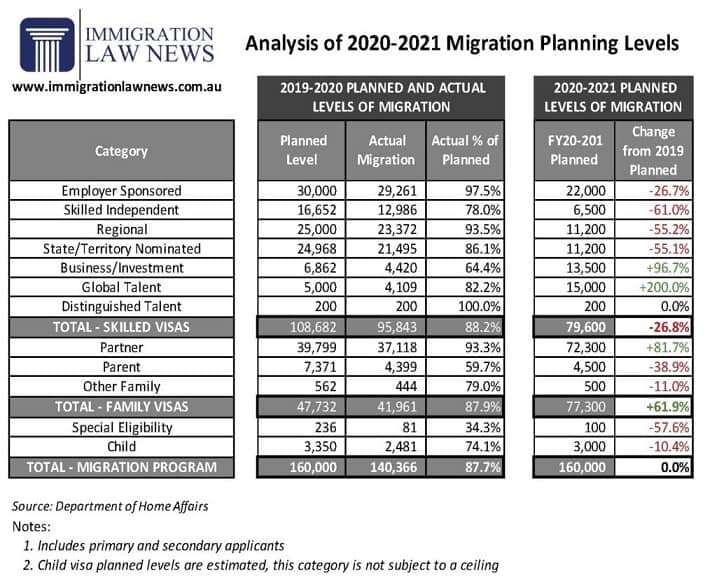The Migration Program for 2020-2021 was finally “announced” on the night of the Federal Budget on 6 October 2020.
Traditionally, the program for the next fiscal year is usually announced in the April of the preceding fiscal year. But with the mayhem of the Covid-19 pandemic the Migration Program for 2020-21 was announced on Federal Budget night on 6 October 2020.
Even then the full migration program was not revealed until 2 days after the Budget night announcement.
This article proposes to do the following:
A. Provide the 2020-21 Migration Program;
B. Give a commentary on the proposed migration program; and
C. Discuss the programs that will be given priority.
A. Migration Program 2020-21
The Migration Program normally comprises two main programs: Family and the Skilled Programs. Traditionally the ratio has been one third Family and two thirds Skilled.
On Budget night this ratio was abandoned and the total Migration Planning Program for 2020-21 is similar to the Planning Program for the year before, 2019-20: 160,000 visas:
Family Program 77,300
- Partner 72,300
- Parent 4,500
- Other Family 500
- Child (* Estimated – Not subject to ceiling) 3,000 *
Skilled Program 79,600
- Employer Sponsored 22,000
- General Skilled Migration 28,900
- Skill Independent 6,500
- State/Terr Nominated 11,200
- Regional 11,200
- Global Talent Independent 15,000
- Business Innovation & Investment Visas 13,500
- Distinguished Talent 200
Special Eligibility 100
Total Migration Planning Program 160,000
Humanitarian Program (separate to the Migration Program) 13,750
B. Commentary On Proposed Program
We will only comment on the Migration Planning Program.
Over the past few months the government has been indicating that migration numbers for 2021 will fall significantly. Indeed on 1 May 2020 the Prime Minister said that Australia’s overseas migration intake will shrink by more than 85 per cent from the 2018-19 levels as a result of the coronavirus.
Was this mere political hype? Perhaps he meant this more holistically when including other programs like Visitor, Student and Temporary Residence programs because the program as announced does not reflect those sentiments.
As mentioned already the overall migration planning level for 2019-20 is exactly the same as that proposed for 2020-21 even though the actual visas issued in 2019-20 was 140,366 and the program composition is different. Hence, the suggestion that the “overseas migration intake” will shrink by more than 85% was probably an exaggeration.
But then the Treasurer Josh Frydenberg in his post-Budget address to the National Press Club on 7 October 2020 flagged that the Budget was premised on the assumption that Australia’s international borders would probably remain closed throughout 2021 when it was also assumed that a vaccine for Covid-19 would be available by that time.
How do we then reconcile that Australia would be able to achieve a migration program of 160,000?
The answer to this can be given in three parts: firstly, this is only a planning level and as occurred in 2019-20 the actual program delivered could be considerably less than 160,000. Secondly, many applicants for permanent residency are already in Australia on Student or other Temporary Residence visas; and thirdly, the Government can always provide exemptions and permit approved visa holders to enter Australia as exempt people, such as the recent relaxation for holders of provisional Business Innovation & Investment Visas.
For all the talk about a decimation of the migration program, the reality is Australia is a migration accepting country and there will always be cogent and strong reasons why Australia will need migration for some years yet to supplement the Australian population. There are many factors for this reliance but the three key reasons are:
- The low birth rate: In 2018, Australia’s birth rate fell to an all-time low of 1.740 babies per female of childbearing age. This low fertility rate means Australia is not replacing its population. According to the UN Population Division, a total fertility rate (TFR) of about 2.1 children per woman is considered the replacement-level fertility.
- Ageing population: The Australian population is ageing. In 2017 it was estimated that 15% of Australians (3.8 million) were aged 65 and over and the projection was that this proportion will grow steadily over the coming decades. This can be attributed in part to a low fertility rate, but also that older Australians are increasing their life expectancy. If the problem of an ageing population is not addressed, such as through an increased population, the consequences of the nation’s lower productivity will mean the burden of increased health and social security costs will fall on the younger population; and
- Economic growth: Importantly, despite a recession, the consensus view among Economists is that migration does impact positively on economic growth. Australia needs migration to grow its economy.
For all these and other reasons, Australia will have a migration program for some years yet! Australia’s demography, fertility and economics will see to that. The issue is the extent and composition of that migration program.
The total for this year’s Planning Program is no different from that of last year: 160,000, except that the program focus and priorities have changed quite significantly as the useful table below, sourced from Immigration Law News website, will show.
The traditional one-third Family and two-third Skilled Migration formula has disappeared, and the main program casualties are the General Skilled Migration (GSM) (subclass 189, 190 and 491) program and the suite of different Parent visas.
What is surprising was the significant increase in the Partner visa allocation which has grown by nearly 82% from the previous year, with the sting that applicants from July 2021 will need to demonstrate that they and their sponsors have functional English language skills. The test applies equally to the Sponsor unless they are Australian citizens.
This increased Partner allocation can be due to Australian sponsors complaining about the long processing times for both onshore and offshore applications of up to 27 months! Given the Partner Visa Application Charge is $7,715 (more if there are accompanying dependent family members), this is not an unreasonable complaint for the exorbitant fees paid.

Source: https://immigrationlawnews.com.au/migration-planning-levels-detailed-comparison-shows-major-cuts-in-many-migration-categories/
What is the impact of the drop in the Parent and GSM allocations?
For Parent visas, undoubtedly the queue for finalising these applications will get longer. The Department has stopped providing processing times for Parent visas, but anecdotally the processing time for Parent visas can now extend to more than 4 years.
The applicants and sponsors are understandably angry about this, especially when the exorbitant second Visa Application Charge of $43,600 per parent is applicable to Contributory Parent visas. They are by far the largest group of applicants in the suite of Parent visas.
The above table will show the GSM allocation shrinking by more than 55% from 2019-20. Inevitably this will mean that getting invitations will be even more competitive. To receive an invitation for the Skill Independent visa in 2019-20 a minimum score of 95 points or higher was expected. This could now be higher as the overall GSM allocations have shrunk considerably.
It is my prediction that the Medium and Short Term Lists of occupations will be reviewed, and the occupations there will shrink in view of the smaller GSM allocation. The points test for GSM applicants will remain very competitive. The role of nominating States and Territories will likely be reviewed too with a view to ensuring that their nominations are more targeted to the needs of their respective jurisdictions.
Given the high unemployment levels that have resulted from Covid-19, it is not surprising that Employer Sponsored Visas have also been reduced by nearly 27% from the Planning Level in 2019-20. With this reduction, it can be expected that Immigration Case Officers will be assessing these Employer Sponsored cases critically to ensure that the market testing and the employer’s need for staff are rigorously assessed.
Clearly from the table, apart from the Partner Program, the other big winners are the Global Talent Independent (GTI) Program which has tripled in size (15,000), and the Business Innovation and Investment Program (BIIP) which has nearly doubled in size (13,500). We will discuss this next.
C. Migration programs that will be given priority
The Covid pandemic has wrought much damage to the national economy. It is therefore not surprising that the government has turned to the Global Talent Independent (GTI), and Business Innovation and Investment Programs (BIIB) to revitalise and spur the economy.
The purpose of the GTI is to seek highly-skilled migrants with exceptional, transferrable skills from around the world to work in a spectrum of future focused technological fields which can contribute to the development of an Australian technological future oriented economy.
This program was only announced by the government in August 2019 and by the end of June 2020 4,109 visas were granted. The vision and success of this program has seen the government tripling the planning level for GTI in 2020-21 at the expense of the GSM allocation which has fallen by more than half because of Covid and the rising high unemployment.
If you are not familiar with the GTI, you might want to read two articles that we have written in our website – here are the links for them:
- https://rcrlaw.com.au/global-talent-independent-visas/
- https://rcrlaw.com.au/global-talent-program-and-distinguished-talent-visa/
The eligibility criteria for GTI is simple but difficult to achieve. For starters the applicant has to come from one of the following seven tech oriented sectors:
- AgTech
- Space and Advanced Manufacturing
- FinTech
- Energy and Mining Technology
- MedTech
- Cyber Security
- Quantum Information, Advanced Digital, Data Science and IT
Then the applicant must show they have the talent, namely, they are:
- internationally recognised with exceptional and outstanding achievements
- still prominent in their field
- an asset to Australia in their area of expertise
- having no difficulty in obtaining employment or be established in their field in Australia
- able to have a relevant organisation or individual in Australia who can endorse their attributes; and
- having the potential or the ability to attract an annual Fair Work High Income Threshold (FWHIT) salary of AUD153,600.
Interestingly for relevant and exceptional Masters or PhD students in Australia who can demonstrate this talent and international recognition, the government has announced that there are places for such students in the program.
Our law firm has experience in assisting applicants for this program: not only has our client received the invitation within a short time but her application was granted 11 days after its lodgement.
Even though the program has grown three fold, we expect that competition for these places will be more intense and assessments will be more difficult. So candidates considering this should seek professional support in their bid for a GTI.
The other winner in the migration program is the Business Innovation and Investment Visa (BIIV) Program (13,500) which has nearly doubled in size from 2019-20. This stance has been our assessment for some time and it is not surprising that our predictions have proven true. It is a no- brainer for this initiative given the havoc that Covid has done to the economy. The BIIV Program will not only bring new business and create much needed new employment, but it will also inject much needed new investment into the economy.
The government has considered this subject so important that it will establish a new whole-of-government Global Business and Talent Attraction Taskforce that will be established to attract international businesses and exceptional talent to Australia to support the post-COVID recovery and to create employment.
The backdrop to this is that the department had already undertaken a review of the BIIV in conjunction with Austrade in 2017. As a continuation of that review the department has more recently initiated a public consultation on the BIIV process, and had requested input before 14 February 2020 on whether:
- there are opportunities to streamline the Business Innovation and Investment program (BIIP) to maximise the value the program generates; and
- increased investment thresholds and different investment types could provide better economic benefits to Australia compared to the current settings used for the Investor visa (IV) and Significant Investor visa (SIV).
This is code for announcing that there will be changes to the BIIV Program. It was expected that these announcements will have been made when the 2020-21 Program was announced on 6 October 2020, but it was not.
But it can be safely assumed that the Government will soon introduce changes to BIIV along the lines of its public consultations brief in ensuring a more targeted approach to business proposals and a new focus on investments will be initiated to improve the economic outcomes of the BIIV Program (BIIP).
The Minister had said as much in his 6 October 2020 Press Release:
The BIIP will also be streamlined and reformed to ensure that investments are targeted at Australian venture capitals and emerging small and medium size businesses to support the economic recovery.
We also know from the Budget that Visa application charges for BIIV will increase by an additional 11.3% (above regular CPI indexation) from 1 July 2021.
Given how Covid has played out in Australia vis-à-vis other parts of the world, Australia can pride itself as a good destination to migrate to and start a new life.
Our law firm has been assisting clients in their business migration application for more than six years with great results, and with expected changes to occur in the near future, we intend to continue this assistance and help applicants get their visas granted and to start new lives in Australia.
Contact the Migration Team
Our team of experienced migration lawyers at Rostron Carlyle Rojas Lawyers can assess your eligibility for these and other migration programs.
We will listen to you and we will provide comprehensive advice regarding your eligibility, address the important threshold issues, and guide and assist you in obtaining the necessary nomination and invitation, and in preparing a decision-ready application.
Please contact any one of us in the Migration Team for assistance, or call (07) 3009 8444:
- Peter K K Lee, Special Counsel: [email protected]
- Clayton Hellen, Senior Associate: [email protected]
- Shanalee Johal, Lawyer: [email protected]



